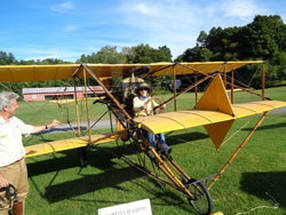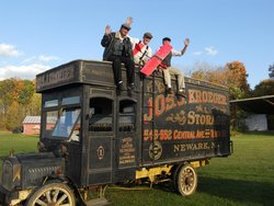 Writing about my great uncle, Addison Hartle in Yours in a Hurry made me wonder what it would be like to sit in the same biplane he built and flew in 1911—and I actually did! As I've said before, researching for historical fiction is the best part of the genre! Rhinebeck Aerodrome Museum Red Hook, New York is just up the road from Franklin and Eleanor Roosevelt's Hyde Park estate. Nearby is possibly the best collection of flying antique airplanes in the country at the Rhinebeck Aerodrome Museum . The museum is 57 years old this year and is devoted to the founder's legacy of presenting aviation history in its purest form—antique aircraft in the skies. They have certainly succeeded! The many famous pioneer and World War I aircraft on display and in the sky includes an original 1909 Bleriot XI similar to the one that Louis Bleriot flew on the first cross-English Channel flight that year. Rhinebeck's Bleriot monoplane is the oldest flying aircraft in the US and the second oldest in the world. Yours in a Hurry describes many early aviation events that included many of the aircraft at Rhinebeck. The 1911 Curtiss Pusher Model The Curtiss biplane on display is similar to the one Addison flew. The Aerodrome’s Curtiss Pusher, shown here with Rhinebeck Aerodrome Museum President Michael DiGiacomio and the author, was built in 1976 and is powered by an original 1911, 80 HP Hall-Scott engine obtained from the Smithsonian Institution. It utilizes the original Curtiss control system. The shoulder yoke controls the ailerons as the pilot leans from side to side. Rotation of the control wheel controls the rudder. Moving the wheel fore and aft control both forward and rear elevators. The right pedal controls the throttle, a center pedal is for the front wheel friction brake, and the left pedal operates an emergency “claw” brake located in the center of the main  Visit Rhinebeck The flying schedule is at http://oldrhinebeck.org/ORA/. The season starts each May and ends in October with alternating History of Flight Air Shows and World War I air shows. As you can see from the photo of the WWI auto, the performances are family oriented. The staff is very personable and knowledgeable and for a reasonable fee you can fly in a biplane like I did. Note: The information above and the photo of the WWI auto from a performance are from the Rhinebeck Aerodrome Museum website with a thank you to the staff for a great visit. The photo of the Curtiss biplane is courtesy of David Otto. Next time: Domestic terrorism isn't new- the LA Times bombing of 1910
0 Comments
|
Archives
August 2020
Categories
All
|
 RSS Feed
RSS Feed